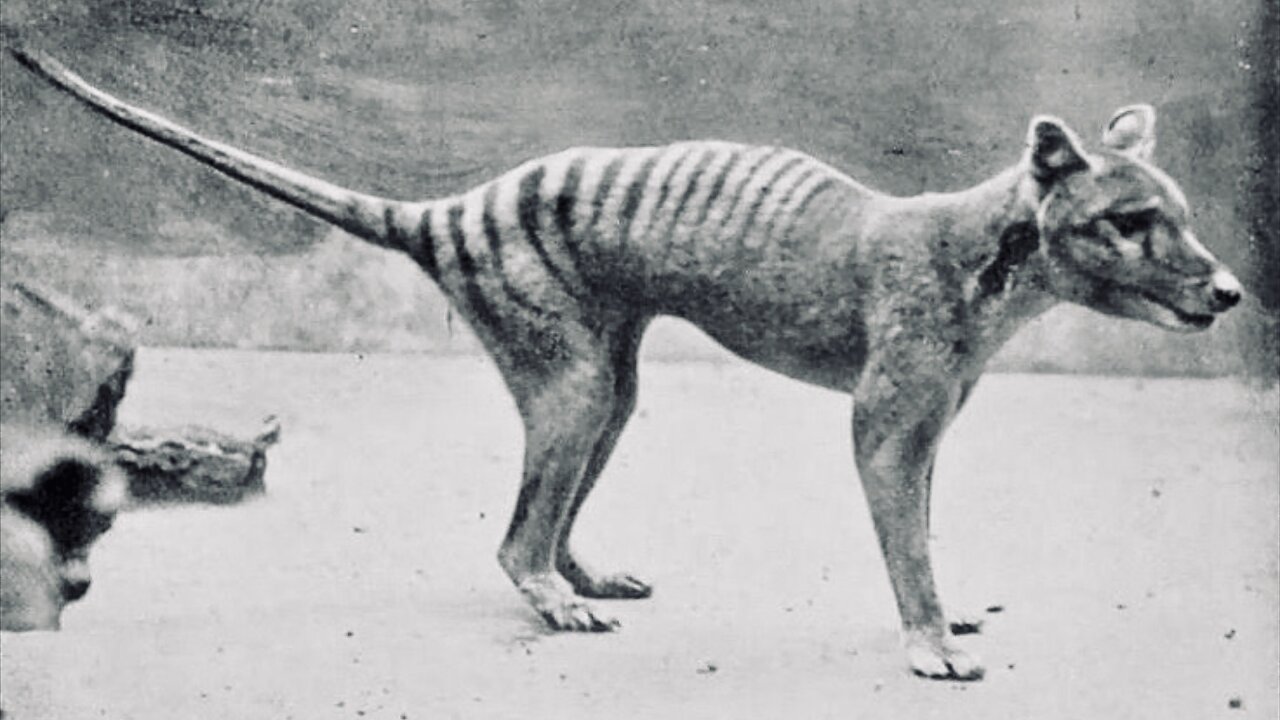Premium Only Content

Rare Footage of Recently Extinct Animals
Once They’re Gone, There’s No Bringing Them Back. Some recently extinct are...The Thylacine - Commonly known as the Tasmanian Tiger, the Thylacine was the largest known carnivorous marsupial of modern times. Virtually wiped out in the wild due to constant hunting (they were thought to be a threat to sheep and other small farm animals) and the encroachment of humans on their already limited habitat the Thylacine was finally recognized as being in danger of becoming extinct in 1936, too little, too late as that same year the last Thylacine, named Benjamin, died on 7 September as the result of neglect — locked out of its sheltered sleeping quarters and exposed to freezing temperatures at night in Hobart Zoo, Tasmania. 60 years on there are still claims of sightings but all are yet to be confirmed.
The Quagga was a southern subspecies of the Plains Zebra. It differed from other zebras mainly in having stripes on the head, neck, and front portion of its body only, and having brownish, rather than white, on its upper parts. The last free Quaggas may have been caught in 1870. The last captive Quagga, a mare, died on 12 August 1883 in Amsterdam Zoo, where she had lived since 9 May 1867. It was not realized that this Quagga mare was the very last of her kind. Because of the confusion caused by the indiscriminate use of the term “Quagga” for any zebra, the true Quagga was hunted to extinction without this being realized until many years later. The Quagga became extinct because it was ruthlessly hunted down for meat and leather by South African farmers, also they were seen by the settlers as competitors, like other wild grass eating animals, for their livestock, mainly
Passenger Pigeon-- The story of the Passenger Pigeon is one of the most tragic extinction stories in modern times. As recently as around 200 years ago they weren’t anywhere near extinction. In fact, they were actually the most common bird in North America, and some reports counted single flocks numbering in the billions. Pigeon meat was commercialized and recognized as cheap food, especially for slaves and the poor, which led to a hunting campaign on a massive scale. Furthermore, due to the large size of their flocks, the birds were seen as a threat to farmers. The last Passenger Pigeon, named Martha, died alone at the Cincinnati Zoo at about 1:00 pm on September 1, 1914.
Golden Toad-- The first record of the Golden Toad was by herpetologist Jay Savage in 1966. The toad, recognized by its brilliant golden orange color, was native to the tropical cloud forests which surround Monteverde, Costa Rica. None have been seen since 1989. It last bred in normal numbers in 1987, and its breeding sites were well known. In 1987, due to erratic weather, the pools dried up before the larva had matured. Out of potential 30,000 toads, only 29 had survived. In 1988, only eight males and two females could be located. In 1989, a single male was found, this was the last record of the species. Extensive searches since this time have failed to produce any more records of the golden toad.
Javan Tigers were a subspecies of tigers which were limited to the Indonesian island of Java. In the early 19th century Javan tigers were so common, that in some areas they were considered nothing more than pests. As the human population increased, large parts of the island were cultivated, leading to a severe reduction of their natural habitat. Wherever man moved in, the Javan tigers were ruthlessly hunted down or poisoned. Natives carried much of the hunting out, a surprising thing since they considered the tiger a reincarnation of their dead relatives. The last specimen to have been seen was sighted in 1972, although there is evidence from track counts that the animal had lingered into the 1980’s. The last track counts to yield evidence of the tigers was held in 1979, when just three tigers were identified. The leading cause of their extinction was agricultural encroachment and habitat loss, which continues to be a serious concern in Java.
According to the International Union for Conservation of Nature, we are now losing animal species at more than 1,000 times the “normal” rate. Here are the top endangered animals in the world… some of whom may sadly be next:
Sumatran Elephant, Leatherback Turtle, Pangolin, Western Lowland Gorilla, Vaquita, Orangutan, Saola.
Also critically endangered: Amur Leopard, Bornean Orangutan, Cross River Gorilla, Eastern Lowland Gorilla, Hawksbill Turtle, Javan Rhino, Mountain Gorilla, South China Tiger, Sumatran Orangutan, Sumatran Rhino, Sumatran Tiger (Source: World Wildlife Fund, 2016)
Music: Kaddish (Instrumental Version) by Dhruva Aliman
Amazon- https://amzn.to/3dgKA52
https://music.apple.com/us/artist/dhruva-aliman/363563637
https://dhruvaaliman.bandcamp.com/album/hard-to-get-along
http://www.dhruvaaliman.com/
Spotify - https://open.spotify.com/artist/5XiFCr9iBKE6Cupltgnlet
#surreal #strange #history
-
 2:19
2:19
Seeker Land
15 days agoFunny - Democrats In Split Screen Saying LA Riots Are Peaceful
52 -
 LIVE
LIVE
Blabs Games
1 hour agoI'm Terrible At This. | Noob Plays
88 watching -
 LIVE
LIVE
Edge of Wonder
6 hours ago3D Holograms You Can Touch & Sound Wave Levitation
350 watching -
 16:42
16:42
Tactical Advisor
14 days agoCan Air Tanks Stop a 50 Cal Sniper Rifle?!
41 -
 LIVE
LIVE
VapinGamers
59 minutes agoFortnite Friday 4 Some with ItalianCEO, GlamourX, DJSkids24 - Rumble Take Over - !rumbot
15 watching -
 LIVE
LIVE
ttvglamourx
9 hours ago $0.12 earnedHAPPY FRIDAY CALL O F DUTY + FORTNITE !DISCORD
66 watching -
![Sea of Thieves with the Crew [#6] Fruity, Booty, and Scooty Puff Jr.](https://1a-1791.com/video/fww1/39/s8/1/B/O/c/X/BOcXy.0kob.1-small-Sea-of-Thieves-with-the-Cre.jpg) LIVE
LIVE
JdaDelete
19 hours agoSea of Thieves with the Crew [#6] Fruity, Booty, and Scooty Puff Jr.
29 watching -
 49:27
49:27
BonginoReport
7 hours agoMaking Education Great Again with Erika Donalds - Nightly Scroll w/ Hayley Caronia (Ep.79)
92.8K10 -
 15:45
15:45
T-SPLY
4 hours agoVice Mayor Denies Asking Gangs To Fight Back Federal Agents!
2.7K2 -
 8:28
8:28
MattMorseTV
4 hours ago $0.11 earnedThe EU just SURRENDERED to Trump.
6.45K9